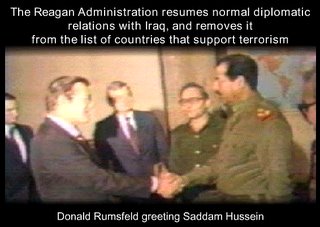
Published on Friday, August 2, 2002 by CommonDreams.org
The Saddam in Rumsfeld’s Closet
by Jeremy Scahill
“Man and the turtle are very much alike. Neither makes any progress without sticking his neck out.”
—Donald Rumsfeld
Five years before Saddam Hussein’s now infamous 1988 gassing of the Kurds, a key meeting took place in Baghdad that would play a significant role in forging close ties between Saddam Hussein and Washington. It happened at a time when Saddam was first alleged to have used chemical weapons. The meeting in late December 1983 paved the way for an official restoration of relations between Iraq and the US, which had been severed since the 1967 Arab-Israeli war.
With the Iran-Iraq war escalating, President Ronald Reagan dispatched his Middle East envoy, a former secretary of defense, to Baghdad with a hand-written letter to Iraqi President Saddam Hussein and a message that Washington was willing at any moment to resume diplomatic relations.
That envoy was Donald Rumsfeld.
VIDEO: Donald Rumsfeld and Saddam Hussein
HOW SADDAM HAPPENED
Congressional Record: September 20, 2002 (Senate)
Page S8987-S8998
Mr. BYRD. Mr. President, yesterday, at a hearing of the Senate Armed
Services Committee, I asked a question of the Secretary of Defense. I
referred to a Newsweek article that will appear in the September 23,
2002, edition. That article reads as follows. It is not overly lengthy.
I shall read it. Beginning on page 35 of Newsweek, here is what the
article says:
America helped make a monster. What to do with him--and
what happens after he is gone--has haunted us for a quarter
century.
The article is written by Christopher Dickey and Evan Thomas. It
reads as follows:
The last time Donald Rumsfeld saw Saddam Hussein, he gave
him a cordial handshake. The date was almost 20 years ago,
Dec. 20, 1983; an official Iraqi television crew recorded the
historic moment.
The once and future Defense secretary, at the time a
private citizen, had been sent by President Ronald Reagan to
Baghdad as a special envoy. Saddam Hussein, armed with a
pistol on his hip, seemed "vigorous and confident,"
according to a now declassified State Department cable
obtained by Newsweek. Rumsfeld "conveyed the President's
greetings and expressed his pleasure at being in Baghdad,"
wrote the notetaker. Then the two men got down to business,
talking about the need to improve relations between their two
countries.
Like most foreign-policy insiders, Rumsfeld was aware that
Saddam was a murderous thug who supported terrorists and was
trying to build a nuclear weapon. (The Israelis had already
bombed Iraq's nuclear reactor at Osirak.) But at the time,
America's big worry was Iran, not Iraq. The Reagan
administration feared that the Iranian revolutionaries who
had overthrown the shah (and taken hostage American diplomats
for 444 days in 1979-81) would overrun the Middle East and
its vital oilfields. On the--theory that the enemy of my
enemy is my friend, the Reaganites were seeking to support
Iraq in a long and bloody war against Iran. The meeting
between Rumsfeld and Saddam was consequential: for the next
five years, until Iran finally capitulated, the United States
backed Saddam's armies with military intelligence, economic
aid and covert supplies of munitions.
Rumsfeld is not the first American diplomat to wish for the
demise of a former ally. After all, before the cold war, the
Soviet Union was America's partner against Hitler in World
War II. In the real world, as the saying goes, nations have
no permanent friends, just permanent interests. Nonetheless,
Rumsfeld's long-ago interlude with Saddam is a reminder that
today's friend can be tomorrow's mortal threat. As President
George W. Bush and his war cabinet ponder Saddam's
successor's regime, they would do well to contemplate how and
why the last three presidents allowed the Butcher of Baghdad
to stay in power so long.
The history of America's relations with Saddam is one of
the sorrier tales in American foreign policy. Time and again,
America turned a blind eye to Saddam's predations, saw him as
the lesser evil or flinched at the chance to unseat him. No
single policymaker or administration deserves blame for
creating, or at least tolerating, a monster; many of their
decisions seemed reasonable at the time. Even so, there are
moments in this clumsy dance with the Devil that make one
cringe. It is hard to believe that, during most of the 1980s,
America knowingly permitted the Iraq Atomic Energy Commission
to import bacterial cultures that might be used to build
biological weapons.
---------------------------------------
Senator Byrd had to ask for additional time in this hearing of the Senate Armed
Services Committee and repeatedly asked Rumsfeld about these biological weapons. This is a lenghty artical, and presents many facts pertaining to chemical biological weapons and Saddams relations to Donald Rumsfeld and US government.
Here's the whole interview...
Congressional Record: September 20, 2002 (Senate)
Page S8987-S8998

Great post, thank you. I don't know if you saw this article/video of Saddam and his inner circle right before the war, but I found it fascinating...
ReplyDeletewww.minor-ripper.blogspot.com